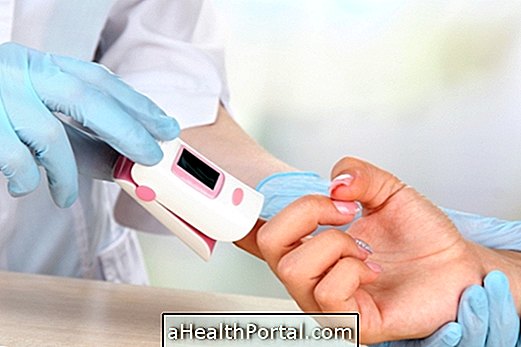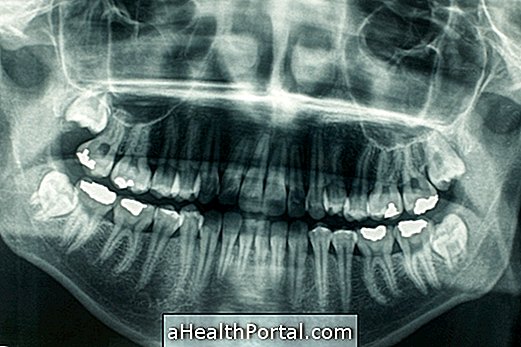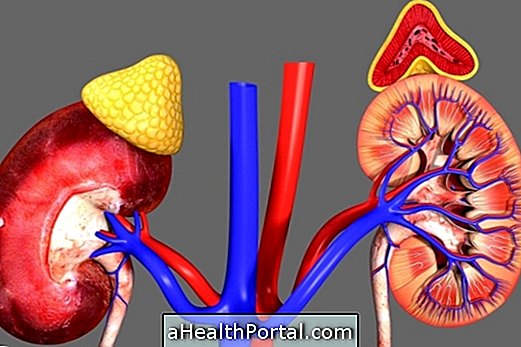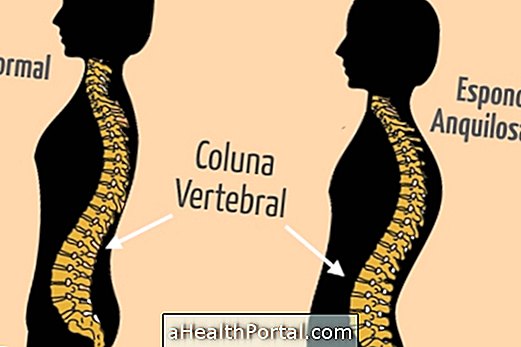Pelvic pain is a pain felt in the lower abdomen, also known as "foot of the belly" and is usually a sign of gynecological, urologic, intestinal or pregnancy related problems.
This symptom is more common in women, but it can also occur in man, being more related to intestinal problems or in the prostate, for example.
To make the correct diagnosis of the cause of this pain you should go to the doctor and do tests such as urine, ultrasound or computed tomography if the doctor feels it is necessary. Depending on the cause, treatment may include the use of analgesics, anti-inflammatories or antibiotics, and there may even be cases where surgery may be necessary, such as in cases of myoma or tumor, for example.

1. Menstrual cramps
It is more common in adolescents and is caused by involuntary uterine contraction during menstruation, tending to improve over the years and with pregnancy. The menstrual cramps that appear later, that presents progressive worsening over the months or that lasts more than the period of the menstruation can indicate other situations, like the endometriosis. Some women report pelvic pain with IUD use, most often due to poor placement of the device inside the uterus.
To treat menstrual cramps the gynecologist can indicate painkillers and anti-inflammatory drugs to be used during periods of pain. In some cases, the use of hormonal pills that help regulate menstruation and relieve pelvic pain can be made.
2. Pregnancy
Pelvic pain in pregnancy is quite common and can have as causes the production of a hormone called relaxin which is responsible for making the ligaments more elastic, making the joints looser for childbirth, and by increasing pressure on the organs and muscles of the region of the pelvis with the advancement of pregnancy.
The pain is not intense, and may start as early as the first trimester of pregnancy or may appear only a few days before delivery. Most of the time the pain arises at the end of the pregnancy when the weight of the belly begins to be greater.
However, in some cases it may indicate a more serious complication of this period, such as ectopic pregnancy or an abortion, so whenever pelvic pain arises early in pregnancy or after a menstrual delay, it is important to consult with a gynecologist .
3. Urinary tract infection or kidney problems
There are several urologic causes that can cause pain in the pelvic region. These include:
- Urinary infection;
- Renal or urinary tract calculi;
- Bladder tumor;
- Changes in the prostate in man, such as inflammation or tumors;
If pelvic pain is accompanied by pain to urinate, blood in the urine or fever, urologic causes are most likely to be checked with the doctor for urinalysis and ultrasound of the urinary tract, if necessary.

4. Endometriosis
Endometriosis is the growth of endometrial tissue outside the uterus, which causes inflammation and pelvic pain that worsens menstruation, increased menstrual flow, and pain during intimate contact and difficulty in getting pregnant. It is not easy to identify endometriosis, and it may be necessary to perform tests such as ultrasound or even biopsy surgery. Understand the main symptoms that indicate endometriosis.
When taken, treatment can be done with pain-relieving medicines, such as Ibuprofen, however, in more severe cases hormone drugs or surgery for endometriosis may be used, which help reduce the amount of endometrial tissue outside the uterus.
5. Uterine myoma
Uterine fibroids are benign tumors formed in the muscle tissue that forms the uterus, and although they do not always cause symptoms, they can cause pelvic pain, bleeding, or difficulty in getting pregnant. Learn more about what is and what causes fibroid.
It is not always necessary to treat, being indicated use of analgesic medicines to relieve the pelvic pain, when necessary. However, when it causes severe symptoms or difficulty getting pregnant, the gynecologist may indicate that surgery or other techniques, such as embolization or cauterization of the uterine wall, are performed to remove the tumor.
6. Ovarian diseases
The presence of cysts, tumors or ovarian infections can cause pelvic pain, as they cause distension, contraction or inflammation of the musculature of the reproductive system, in addition to increasing the risk of ovarian torsion, a situation called adnexal torsion. In these cases, it may be necessary to use anti-inflammatory drugs, antibiotics or surgery, according to each case.
Another common cause of pelvic pain is ovulatory pain, also known as "middle pain, " because it occurs during ovulation, since there is intense hormonal stimulation in this period, with release of the oocytes by the ovary, which can cause pain that usually, lasts 1 to 2 days. Pain relief can be done with analgesics or anti-inflammatories that can relieve symptoms when they arise.
7. Pelvic Inflammatory Disease
It is a disease that causes inflammation in the woman's internal genitalia, usually when a genital infection reaches the uterine cervix and reaches the uterus, and can rise to the fallopian tubes and ovaries. It is usually caused by bacteria that may be sexually transmitted, and can be acute or chronic infections, and may persist for several months or years.
Treatment for pelvic inflammatory disease can be done with the use of antibiotics orally or intramuscularly for about 14 days, and in some cases surgery is needed to treat inflammation of the uterine tubes or for ovarian tube abscess drainage. It is also recommended that the partner be treated, even if he has no symptoms, to avoid recontamination.

8. Vulvovaginites
Other types of genital infections, such as those caused by candidiasis, bacterial vaginosis or trichomoniasis, for example, can also cause pelvic pain. Although this type of infection can occur in all women and at any age, it is more frequent in those who have already started sexual activity, since intimate contact facilitates contact with microorganisms. Check out how to identify and treat vulvovaginitis.
9. Appendicitis or diverticulitis
Bowel diseases such as gastroenteritis, appendicitis, diverticulitis, inflammatory bowel disease, irritable bowel disease or even cancer are also causes of pelvic pain. They are usually associated with changes in bowel rhythm, such as diarrhea, in addition to nausea and vomiting.
Inguinal hernia
The presence of a hernia in the pelvic region can cause pain in this region, just as the inflammation or injury of any muscle located in this area causes this symptom. Abdominal wall hematoma, common after a bump in the region, even if it is not visible, is a cause of pain that can be severe.
Other more rare causes of pelvic pain may include changes in blood circulation, diseases of the nervous system or even autoimmune, but are generally suspected when the most probable causes are ruled out by medical evaluation.
What to do in case of pelvic pain
Because the causes of pelvic pain are very varied, whenever pain is severe or persists for more than 1 day, it is important to seek medical evaluation for effective diagnosis and treatment.
In addition, the annual consultation with the gynecologist or urologist is important for the detection of changes that may not be noticed at the outset, which can prevent serious problems and avoid future complications, improving health and well-being.
However you can try some natural painkillers, which you can watch in the following video:























